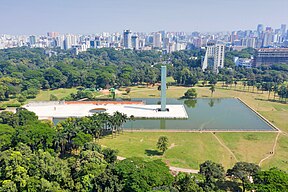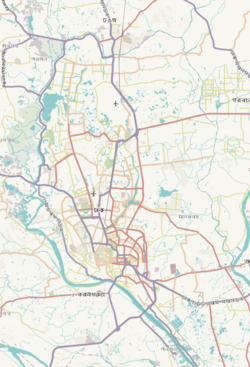Dhaka (/ˈdɑːkə/ DAH-kə or /ˈdækə/ DAK-ə; Bengali: ঢাকা, romanized: Ḍhākā, pronounced [ˈɖʱaka] ), formerly known as Dacca,[20] is the capital and largest city of Bangladesh. It is the ninth-largest and seventh-most densely populated city in the world with a density of 23,234 people per square kilometer within a total area of approximately 300 square kilometers.[21] Dhaka is a megacity, and has a population of 10.2 million residents as of 2024, and a population of over 23.9 million residents in Dhaka Metropolitan Area.[22][14][23] It is widely considered to be the most densely populated built-up urban area in the world.[24][25] Dhaka is the most important cultural, economic, and scientific hub of Eastern South Asia, as well as a major Muslim-majority city. Dhaka ranks third in South Asia and 39th in the world in terms of GDP. Lying on the Ganges Delta, it is bounded by the Buriganga, Turag, Dhaleshwari and Shitalakshya rivers. Dhaka is also the largest Bengali-speaking city in the world.
The area of Dhaka has been inhabited since the first millennium. An early modern city developed from the 17th century as a provincial capital and commercial centre of the Mughal Empire. Dhaka was the capital of a proto-industrialized Mughal Bengal for 75 years (1608–39 and 1660–1704). It was the hub of the muslin trade in Bengal and one of the most prosperous cities in the world. The Mughal city was named Jahangirnagar (The City of Jahangir) in honour of the erstwhile ruling emperor Jahangir.[26][27][28] The city's wealthy Mughal elite included princes and the sons of Mughal emperors. The pre-colonial city's glory peaked in the 17th and 18th centuries, when it was home to merchants from across Eurasia. The Port of Dhaka was a major trading post for both riverine and seaborne trade. The Mughals decorated the city with well-laid gardens, tombs, mosques, palaces, and forts. The city was once called the Venice of the East.[29]
Under British rule, the city saw the introduction of electricity, railways, cinemas, Western-style universities and colleges and a modern water supply. It became an important administrative and educational centre in the British Raj, as the capital of Eastern Bengal and Assam province after 1905.[30] In 1947, after the end of British rule, the city became the administrative capital of East Pakistan. It was declared the legislative capital of Pakistan in 1962. In 1971, following the Liberation War, it became the capital of independent Bangladesh. In 2008, Dhaka celebrated 400 years as a municipal city.[31][32][33]
A gamma+ global city,[34] Dhaka is the centre of political, economic and cultural life in Bangladesh. It is the seat of the Government of Bangladesh, many Bangladeshi companies, and leading Bangladeshi educational, scientific, research, and cultural organizations. Since its establishment as a modern capital city, the population, area and social and economic diversity of Dhaka have grown tremendously. The city is now one of the most densely industrialized regions in the country. The city accounts for 35% of Bangladesh's economy.[35] The Dhaka Stock Exchange has over 750 listed companies. Dhaka hosts over 50 diplomatic missions; as well as the headquarters of BIMSTEC, CIRDAP, and the International Jute Study Group. Dhaka has a renowned culinary heritage. The city's culture is known for its rickshaws, Kachi Biryani, art festivals, street food, and religious diversity. Dhaka's most prominent architectural landmark is the modernist Jatiyo Sangshad Bhaban; while it has a heritage of 2000 buildings from the Mughal and British periods.[36] The city is associated with two Nobel laureates. Dhaka's annual Bengali New Year parade, its Jamdani sari, and its rickshaw art have been recognized by UNESCO as the intangible cultural heritage of humanity.[37][38][39] The city has produced many writers and poets in several languages, especially in Bengali and English.
- ^ Imam, Shah Husain (20 July 2018). "Dhaka: Where will it go from here?". The Daily Star (Opinion). Archived from the original on 2 March 2023. Retrieved 2 March 2022.
Dhaka, once the Venice of the East by virtue of being surrounded by four ebullient rivers, is now an urban behemoth.
- ^ "The tales of urban street children:Is there anything we could do?". Dhaka Tribune. 10 December 2019. Archived from the original on 1 August 2021. Retrieved 2 April 2021.
- ^ "Are we willing to know more of Dhaka?". The Daily Star. 4 May 2018. Archived from the original on 3 August 2021. Retrieved 2 April 2021.
- ^ The city of mosques The city of mosques (https://www.dhakatribune.com/amp/opinion/heritage/5361/the-city-of-mosques)
- ^ "Dhaka: The city that (still) never sleeps". Dhaka Tribune. 16 June 2020.
- ^ Chowdhury, Sanjana (27 November 2021). "রিকশা বৃত্তান্ত: কবে, কোথা থেকে, কে প্রথম এই বাহনটি বাংলাদেশে আনেন". BBC (in Bengali). Retrieved 28 March 2024.
- ^ a b "Dhaka Metropolitan City Area". Archived from the original on 29 September 2017. Retrieved 29 September 2017.
- ^ Partha Pratim Bhattacharjee; Mahbubur Rahman Khan (7 May 2016). "Govt to double size of Dhaka city area". The Daily Star. Archived from the original on 2 March 2017. Retrieved 1 March 2017.
- ^ "Dhaka City expands by more than double after inclusion of 16 union councils". bdnews24.com. 9 May 2016. Archived from the original on 2 March 2017. Retrieved 1 March 2017.
- ^ "Largest Cities by Population 2024". worldpopulationreview.com. Retrieved 9 October 2024.
- ^ "Dhaka, Bangladesh Map". National Geographic. Archived from the original on 7 January 2010. Retrieved 6 September 2009.
- ^ "Largest Cities by Population 2024". worldpopulationreview.com. Retrieved 9 October 2024.
- ^ "Dhaka (Bangladesh): City Districts and Subdistricts - Population Statistics, Charts and Map". City Population. Archived from the original on 3 February 2019. Retrieved 19 January 2022.
- ^ a b "Population & Housing Census-2011" (PDF). Bangladesh Bureau of Statistics. p. 41. Archived from the original (PDF) on 8 December 2015. Retrieved 15 December 2015.
- ^ "Evolving Urban Form: Dhaka". Newgeography.com. Archived from the original on 11 June 2013. Retrieved 19 January 2022.
- ^ "District Statistics 2011, Dhaka" (PDF). Bangladesh Bureau of Statistics. December 2013. Archived from the original (PDF) on 24 April 2015. Retrieved 14 May 2015.
- ^ "TelluBase—Dhaka Fact Sheet (Tellusant Public Service Series)" (PDF). Retrieved 10 October 2024.
- ^ "Sub-national HDI - Area Database - Global Data Lab". hdi.globaldatalab.org. Archived from the original on 8 February 2023. Retrieved 8 February 2023.
- ^ "Unesco lists rickshaws and rickshaw art as 'intangible heritage'". The Daily Start. 6 December 2023.
- ^ Choguill, C.L. (2012). New Communities for Urban Squatters: Lessons from the Plan That Failed in Dhaka, Bangladesh. Springer Science & Business Media. p. viii. ISBN 978-1-4613-1863-7. Archived from the original on 5 June 2020. Retrieved 10 July 2016.
- ^ "Dhaka, Bangladesh Population 2024". worldpopulationreview.com. Retrieved 2 October 2024.
- ^ "Dhaka ranks world's sixth most populous city". Dhaka Tribune. 14 January 2022. Archived from the original on 15 January 2023. Retrieved 15 January 2023.
- ^ "The World's Most Densely Populated Cities". WorldAtlas. 4 October 2020. Archived from the original on 19 March 2022. Retrieved 11 March 2022.
- ^ Demographia World Urban Areas 17th Annual Edition: 202106 (PDF). Demographia. Demographia. Archived (PDF) from the original on 3 May 2018. Retrieved 2 February 2022.
- ^ Ferreira, Luana (3 September 2021). "Here's How Many People Live In The Most Densely Populated City On Earth". Grunge.com. Archived from the original on 2 February 2022. Retrieved 2 February 2022.
- ^ "From Jahangirnagar to Dhaka". Forum. The Daily Star. Archived from the original on 8 April 2022. Retrieved 4 March 2022.
- ^ "Islam Khan Chisti". Banglapedia. 18 June 2021. Archived from the original on 4 March 2022. Retrieved 4 March 2022.
- ^ Khondker, Kamrun Nessa (December 2012). Mughal River Forts in Bangladesh (1575-1688): An Archaeological Appraisal (PDF) (PhD thesis). School of History, Archaeology and Religion, Cardiff University. Archived (PDF) from the original on 4 March 2022. Retrieved 4 March 2022.
- ^ Hough, Michael (2004) [First published 1995]. Cities and Natural Process: A Basis for Sustainability (2nd ed.). Psychology Press. p. 57. ISBN 978-0-415-29854-4. Retrieved 26 August 2017.
- ^ Dani, Ahmad Hasan (1962) [First published 1956]. Dacca: A record of its changing fortunes (2nd ed.). Mrs. Safiya S. Dani. pp. 98, 118–119, 126. OCLC 987755973.
- ^ "400 years of Dhaka". The Daily Star (Editorial). 1 December 2008. Archived from the original on 18 December 2022. Retrieved 18 December 2022.
- ^ "Bangladesh CA Inaugurates Three-year Gala Celebrations of 400 Anniversary of Dhaka". VOA Bangla. 28 November 2008. Archived from the original on 18 December 2022. Retrieved 18 December 2022.
- ^ 400 Years of Capital Dhaka and Beyond: Economy and culture. Vol. 2. Asiatic Society of Bangladesh. 2011. ISBN 9789845120128. Archived from the original on 11 February 2023. Retrieved 29 January 2023.
- ^ "World Cities 2024". GaWC. Retrieved 8 November 2024.
- ^ Cite error: The named reference
Rezaul Karimwas invoked but never defined (see the help page). - ^ "Living like there is no past". The Daily Star. 17 June 2019. Archived from the original on 21 August 2023. Retrieved 1 September 2023.
- ^ "Mangal Shobhajatra on Pahela Baishakh". UNESCO Intangible Cultural Heritage. Archived from the original on 8 May 2017. Retrieved 1 September 2023.
- ^ "UNESCO - Traditional art of Jamdani weaving".
- ^ "UNESCO - Rickshaws and rickshaw painting in Dhaka".










